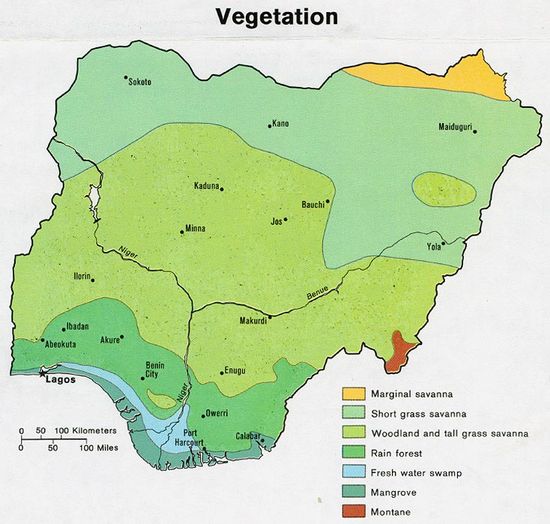Forests in Nigeria
a summary guide
State
Despite the association of Nigeria with rich biological diversity and striking endemism, (“occurring only within a distinct area”) in its rainforest, the country’s terrestrial habitats are mainly savanna woodland and grassland. Montane vegetation grows on some elevations above 1 500m in the eastern margins of the country. Mambilla and Obudu hills are accessible examples. The southern forest belt is the hub of economic activity in Nigeria – oil wells, industrial establishments; large towns and villages interconnected with a network of roads, embedded in land with one of the highest population densities on the African continent.
140 million people growing at almost 3% per annum has consequences – all but 10% of the original forest estate is left in Nigeria! The resulting high ecological footprint is gradually spreading to the country’s northern borders. Progressive “sahelization of the savanna” and even stark desert encroachments are currently not rare. In southern Nigeria, the oil industry has shaved off swathes of rich mangrove forests in the Niger delta. Population drift to coastal cities, Lagos, Port Harcourt, Calabar, Warri, Yenagoa, Badagry impact moist forests that protect a low-lying Atlantic shoreline from storm surges and erosion.
Biodiversity
31% of the remaining forests in Nigeria are in Cross River State, which shares a boundary with Cameroon. The gene pool is impressive because this area survived the great ice age that affected the whole of central and West Africa many millions of years ago. There are more than 400 varieties of trees, around 170 species of reptiles and amphibians, 140 fish species in Cross River State. Of the 904 bird species recorded in Nigeria, 425 occur in Cross River. Endemic to these habitats and the adjacent Cameroon forests are the “Western mountain” gorilla, drills, and the redheaded rockfowl, Picathartes. Sclater’s monkey, the red-bellied and white-throated guenons are found only in Nigeria. Ibadan malimbe, Malimbus ibadanensis, a type of weaver bird is endemic to the forests of south-western Nigeria, around Ibadan in Oyo State.

Forest uses
There are unhealthy demands on Nigerian forests for wood, food, fuels, industrial materials, medicines.
Threats
Unsustainable (largely illegal) logging, agricultural encroachment, over-harvesting of non-timber forest products, overgrazing of livestock in the savanna, infrastructure development, inadequate and ineffective legal frameworks for forest governance, poor research, insecurity of land tenure are the major threats. Will Nigerian forests in the near future be converted to production of feedstock for biofuels, i.e. into plantations to grow soybeans, cassava, sugar-cane, oil palm, nipa palm, maize, allanblackia, jatropha, etc.?
Climate change
Forests the world over are vast stores of carbon. Resulting from photosynthesis, there is more carbon stored in the trees of the world than in the atmosphere. In the process, tropical forests can absorb 10% of annual man-made greenhouse gas emissions. But destruction of these forests contributes over 17% of man-made emissions per annum, to cite a recent IPCC report.

Solutions
Destruction of rainforests is an environmental problem that needs an economic solution. In order to out-compete the drivers of deforestation, carbon credits must be generated for forested states if they reduce vegetation loss to an agreed level each year. This can be monitored by satellite technology. The monies paid could then be channeled into engaging and training forestry personnel and park rangers, drafting of new forestry laws, agricultural intensification, renewable energy, education and small businesses, and building better roads and infrastructure in order to stimulate development and create alternative livelihoods.
Ako Amadi
Abuja, 24.March, 2010
